HAT302 - Food & Beverage Management: BurgerFuel Menu Review
VerifiedAdded on 2023/06/13
|6
|1319
|246
Report
AI Summary
This paper presents a comprehensive review of the BurgerFuel menu, a New Zealand-based food and beverage outlet specializing in fast-food items. The review encompasses an analysis of the existing menu, including its structure, item classifications, variety, and nutritional value. Potential issues within the menu design, particularly concerning high fat and calorie content, are identified, and an alternative menu concept is proposed to address these concerns. The paper suggests a redesign focused on balancing nutritional values, reducing fats and calories, and increasing carbohydrate and protein levels. The importance of aligning the menu with consumer dietary needs and affordability is emphasized. Desklib provides a platform for students to access similar solved assignments and past papers for academic support.
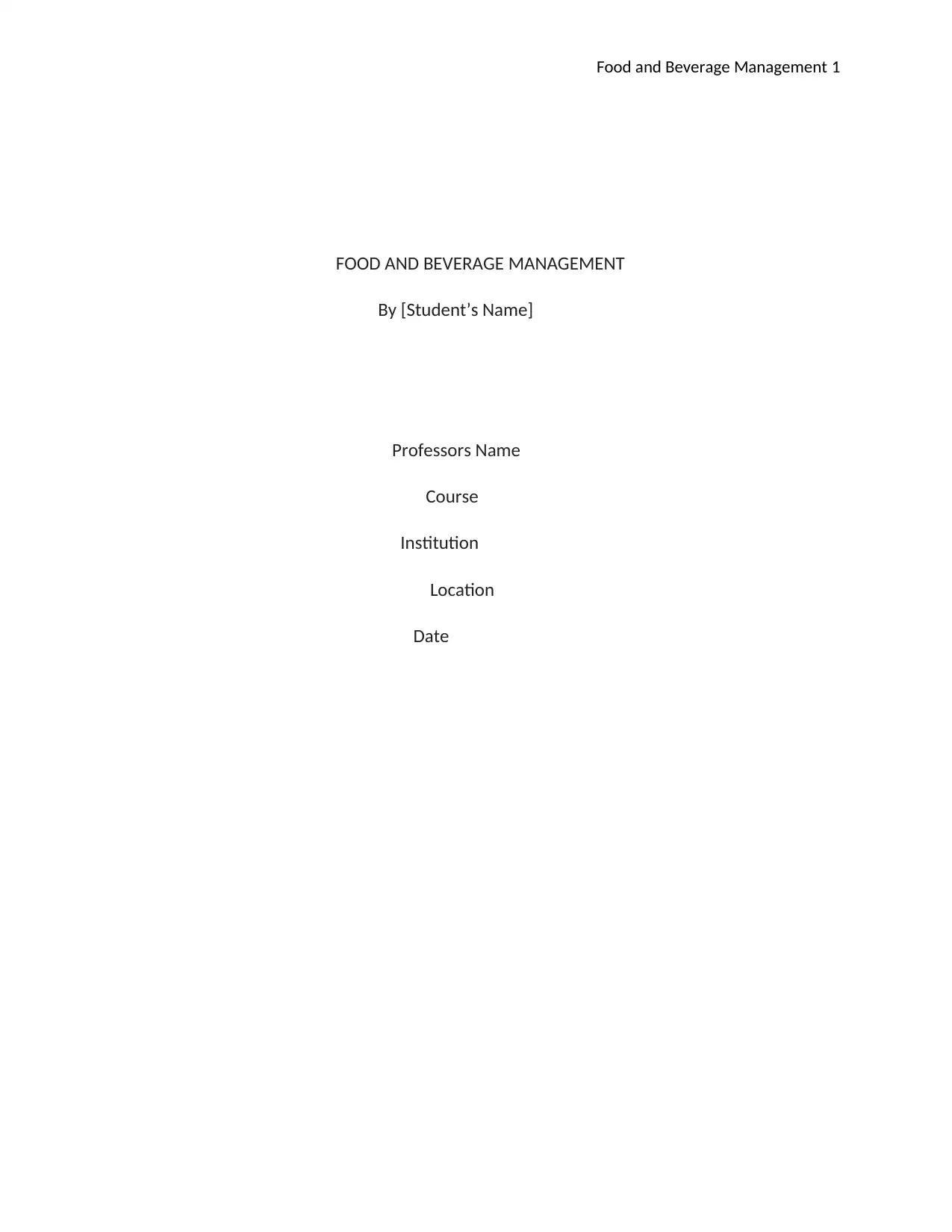
Food and Beverage Management 1
FOOD AND BEVERAGE MANAGEMENT
By [Student’s Name]
Professors Name
Course
Institution
Location
Date
FOOD AND BEVERAGE MANAGEMENT
By [Student’s Name]
Professors Name
Course
Institution
Location
Date
Paraphrase This Document
Need a fresh take? Get an instant paraphrase of this document with our AI Paraphraser
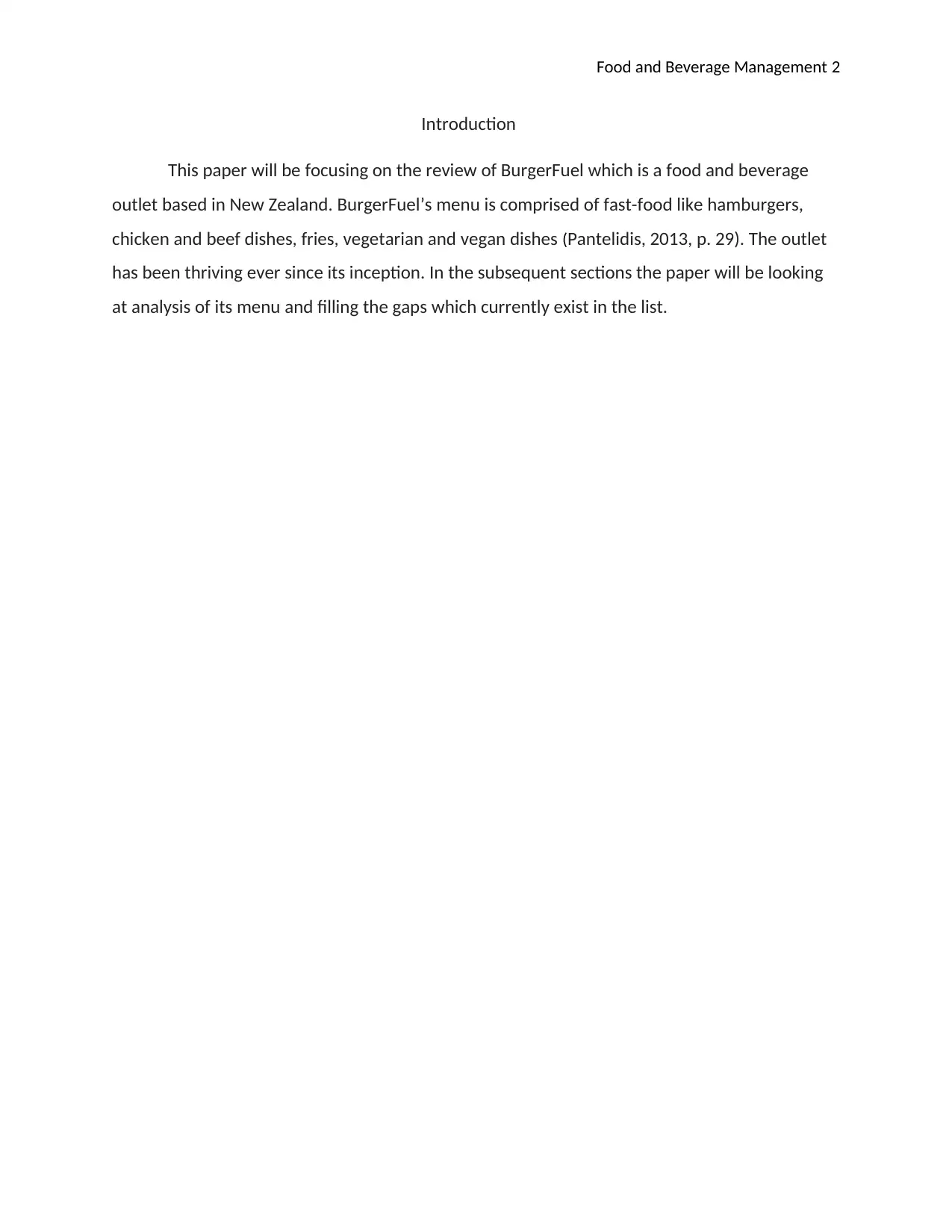
Food and Beverage Management 2
Introduction
This paper will be focusing on the review of BurgerFuel which is a food and beverage
outlet based in New Zealand. BurgerFuel’s menu is comprised of fast-food like hamburgers,
chicken and beef dishes, fries, vegetarian and vegan dishes (Pantelidis, 2013, p. 29). The outlet
has been thriving ever since its inception. In the subsequent sections the paper will be looking
at analysis of its menu and filling the gaps which currently exist in the list.
Introduction
This paper will be focusing on the review of BurgerFuel which is a food and beverage
outlet based in New Zealand. BurgerFuel’s menu is comprised of fast-food like hamburgers,
chicken and beef dishes, fries, vegetarian and vegan dishes (Pantelidis, 2013, p. 29). The outlet
has been thriving ever since its inception. In the subsequent sections the paper will be looking
at analysis of its menu and filling the gaps which currently exist in the list.
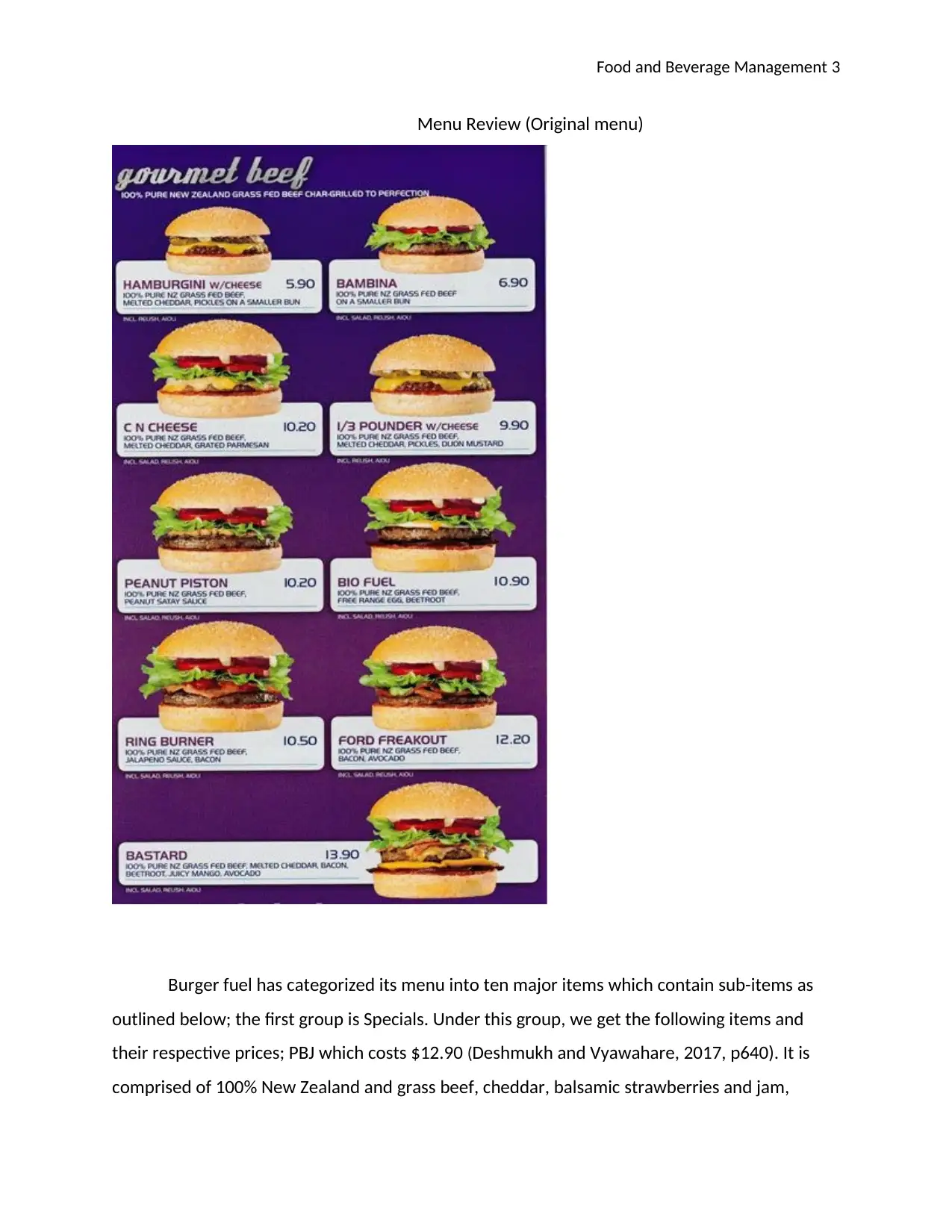
Food and Beverage Management 3
Menu Review (Original menu)
Burger fuel has categorized its menu into ten major items which contain sub-items as
outlined below; the first group is Specials. Under this group, we get the following items and
their respective prices; PBJ which costs $12.90 (Deshmukh and Vyawahare, 2017, p640). It is
comprised of 100% New Zealand and grass beef, cheddar, balsamic strawberries and jam,
Menu Review (Original menu)
Burger fuel has categorized its menu into ten major items which contain sub-items as
outlined below; the first group is Specials. Under this group, we get the following items and
their respective prices; PBJ which costs $12.90 (Deshmukh and Vyawahare, 2017, p640). It is
comprised of 100% New Zealand and grass beef, cheddar, balsamic strawberries and jam,
⊘ This is a preview!⊘
Do you want full access?
Subscribe today to unlock all pages.

Trusted by 1+ million students worldwide
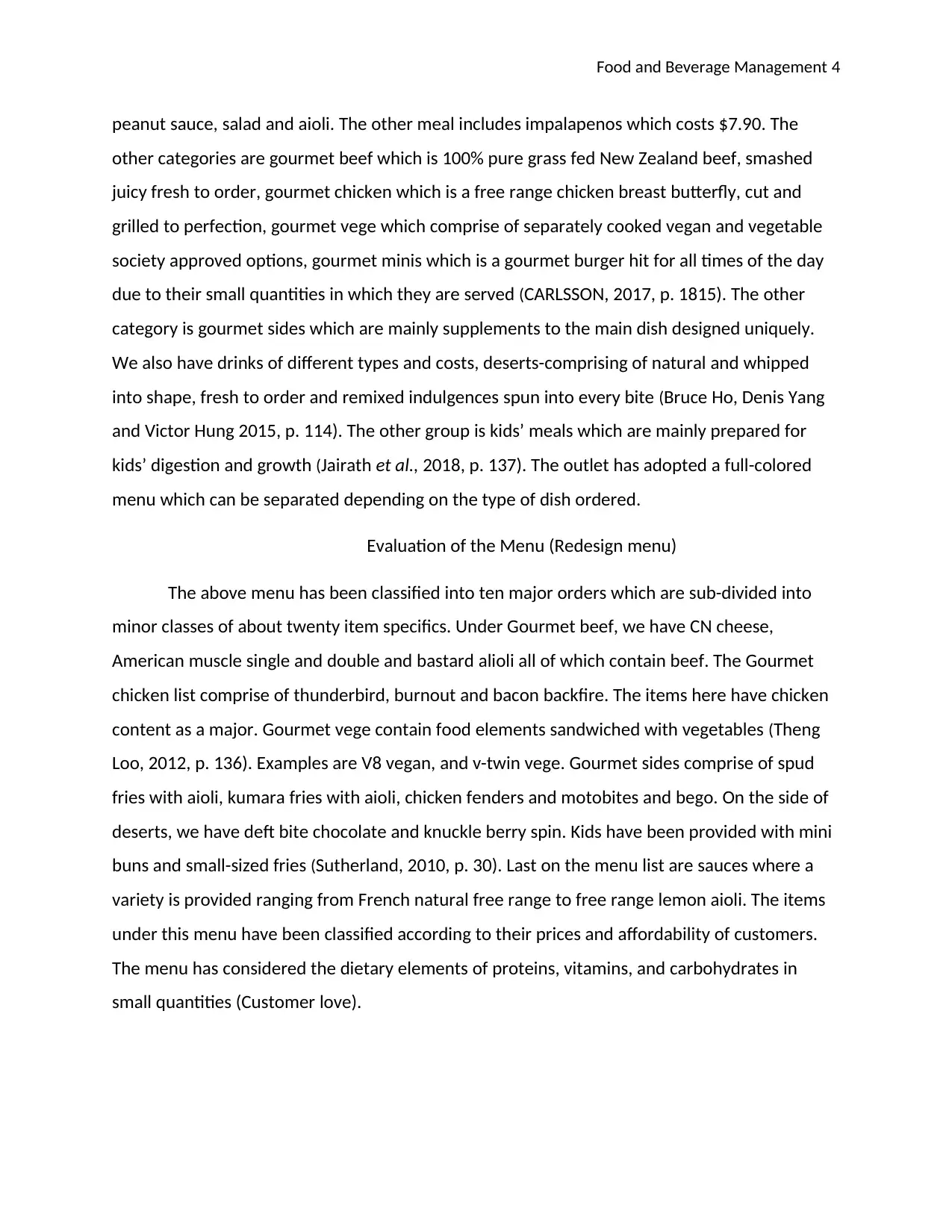
Food and Beverage Management 4
peanut sauce, salad and aioli. The other meal includes impalapenos which costs $7.90. The
other categories are gourmet beef which is 100% pure grass fed New Zealand beef, smashed
juicy fresh to order, gourmet chicken which is a free range chicken breast butterfly, cut and
grilled to perfection, gourmet vege which comprise of separately cooked vegan and vegetable
society approved options, gourmet minis which is a gourmet burger hit for all times of the day
due to their small quantities in which they are served (CARLSSON, 2017, p. 1815). The other
category is gourmet sides which are mainly supplements to the main dish designed uniquely.
We also have drinks of different types and costs, deserts-comprising of natural and whipped
into shape, fresh to order and remixed indulgences spun into every bite (Bruce Ho, Denis Yang
and Victor Hung 2015, p. 114). The other group is kids’ meals which are mainly prepared for
kids’ digestion and growth (Jairath et al., 2018, p. 137). The outlet has adopted a full-colored
menu which can be separated depending on the type of dish ordered.
Evaluation of the Menu (Redesign menu)
The above menu has been classified into ten major orders which are sub-divided into
minor classes of about twenty item specifics. Under Gourmet beef, we have CN cheese,
American muscle single and double and bastard alioli all of which contain beef. The Gourmet
chicken list comprise of thunderbird, burnout and bacon backfire. The items here have chicken
content as a major. Gourmet vege contain food elements sandwiched with vegetables (Theng
Loo, 2012, p. 136). Examples are V8 vegan, and v-twin vege. Gourmet sides comprise of spud
fries with aioli, kumara fries with aioli, chicken fenders and motobites and bego. On the side of
deserts, we have deft bite chocolate and knuckle berry spin. Kids have been provided with mini
buns and small-sized fries (Sutherland, 2010, p. 30). Last on the menu list are sauces where a
variety is provided ranging from French natural free range to free range lemon aioli. The items
under this menu have been classified according to their prices and affordability of customers.
The menu has considered the dietary elements of proteins, vitamins, and carbohydrates in
small quantities (Customer love).
peanut sauce, salad and aioli. The other meal includes impalapenos which costs $7.90. The
other categories are gourmet beef which is 100% pure grass fed New Zealand beef, smashed
juicy fresh to order, gourmet chicken which is a free range chicken breast butterfly, cut and
grilled to perfection, gourmet vege which comprise of separately cooked vegan and vegetable
society approved options, gourmet minis which is a gourmet burger hit for all times of the day
due to their small quantities in which they are served (CARLSSON, 2017, p. 1815). The other
category is gourmet sides which are mainly supplements to the main dish designed uniquely.
We also have drinks of different types and costs, deserts-comprising of natural and whipped
into shape, fresh to order and remixed indulgences spun into every bite (Bruce Ho, Denis Yang
and Victor Hung 2015, p. 114). The other group is kids’ meals which are mainly prepared for
kids’ digestion and growth (Jairath et al., 2018, p. 137). The outlet has adopted a full-colored
menu which can be separated depending on the type of dish ordered.
Evaluation of the Menu (Redesign menu)
The above menu has been classified into ten major orders which are sub-divided into
minor classes of about twenty item specifics. Under Gourmet beef, we have CN cheese,
American muscle single and double and bastard alioli all of which contain beef. The Gourmet
chicken list comprise of thunderbird, burnout and bacon backfire. The items here have chicken
content as a major. Gourmet vege contain food elements sandwiched with vegetables (Theng
Loo, 2012, p. 136). Examples are V8 vegan, and v-twin vege. Gourmet sides comprise of spud
fries with aioli, kumara fries with aioli, chicken fenders and motobites and bego. On the side of
deserts, we have deft bite chocolate and knuckle berry spin. Kids have been provided with mini
buns and small-sized fries (Sutherland, 2010, p. 30). Last on the menu list are sauces where a
variety is provided ranging from French natural free range to free range lemon aioli. The items
under this menu have been classified according to their prices and affordability of customers.
The menu has considered the dietary elements of proteins, vitamins, and carbohydrates in
small quantities (Customer love).
Paraphrase This Document
Need a fresh take? Get an instant paraphrase of this document with our AI Paraphraser
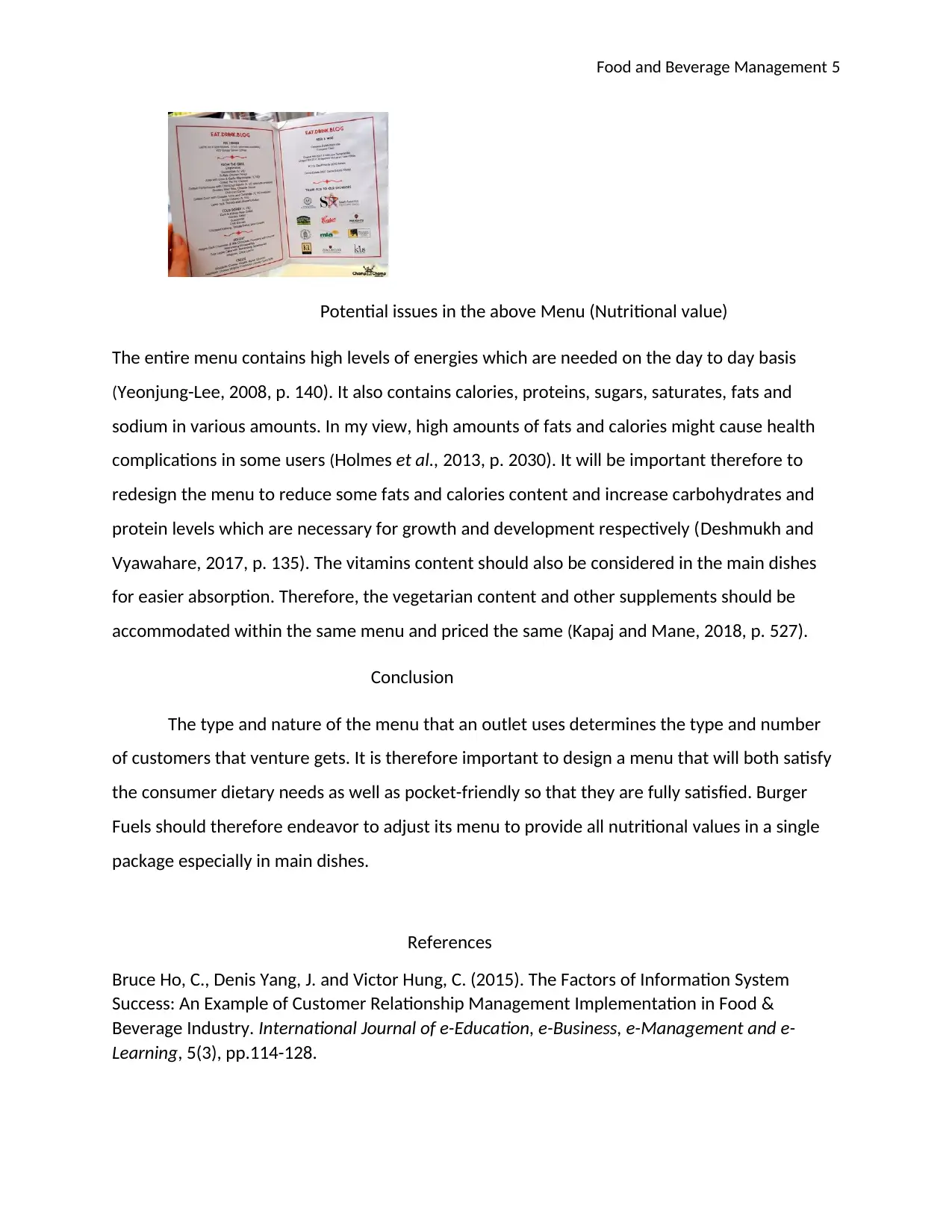
Food and Beverage Management 5
Potential issues in the above Menu (Nutritional value)
The entire menu contains high levels of energies which are needed on the day to day basis
(Yeonjung-Lee, 2008, p. 140). It also contains calories, proteins, sugars, saturates, fats and
sodium in various amounts. In my view, high amounts of fats and calories might cause health
complications in some users (Holmes et al., 2013, p. 2030). It will be important therefore to
redesign the menu to reduce some fats and calories content and increase carbohydrates and
protein levels which are necessary for growth and development respectively (Deshmukh and
Vyawahare, 2017, p. 135). The vitamins content should also be considered in the main dishes
for easier absorption. Therefore, the vegetarian content and other supplements should be
accommodated within the same menu and priced the same (Kapaj and Mane, 2018, p. 527).
Conclusion
The type and nature of the menu that an outlet uses determines the type and number
of customers that venture gets. It is therefore important to design a menu that will both satisfy
the consumer dietary needs as well as pocket-friendly so that they are fully satisfied. Burger
Fuels should therefore endeavor to adjust its menu to provide all nutritional values in a single
package especially in main dishes.
References
Bruce Ho, C., Denis Yang, J. and Victor Hung, C. (2015). The Factors of Information System
Success: An Example of Customer Relationship Management Implementation in Food &
Beverage Industry. International Journal of e-Education, e-Business, e-Management and e-
Learning, 5(3), pp.114-128.
Potential issues in the above Menu (Nutritional value)
The entire menu contains high levels of energies which are needed on the day to day basis
(Yeonjung-Lee, 2008, p. 140). It also contains calories, proteins, sugars, saturates, fats and
sodium in various amounts. In my view, high amounts of fats and calories might cause health
complications in some users (Holmes et al., 2013, p. 2030). It will be important therefore to
redesign the menu to reduce some fats and calories content and increase carbohydrates and
protein levels which are necessary for growth and development respectively (Deshmukh and
Vyawahare, 2017, p. 135). The vitamins content should also be considered in the main dishes
for easier absorption. Therefore, the vegetarian content and other supplements should be
accommodated within the same menu and priced the same (Kapaj and Mane, 2018, p. 527).
Conclusion
The type and nature of the menu that an outlet uses determines the type and number
of customers that venture gets. It is therefore important to design a menu that will both satisfy
the consumer dietary needs as well as pocket-friendly so that they are fully satisfied. Burger
Fuels should therefore endeavor to adjust its menu to provide all nutritional values in a single
package especially in main dishes.
References
Bruce Ho, C., Denis Yang, J. and Victor Hung, C. (2015). The Factors of Information System
Success: An Example of Customer Relationship Management Implementation in Food &
Beverage Industry. International Journal of e-Education, e-Business, e-Management and e-
Learning, 5(3), pp.114-128.
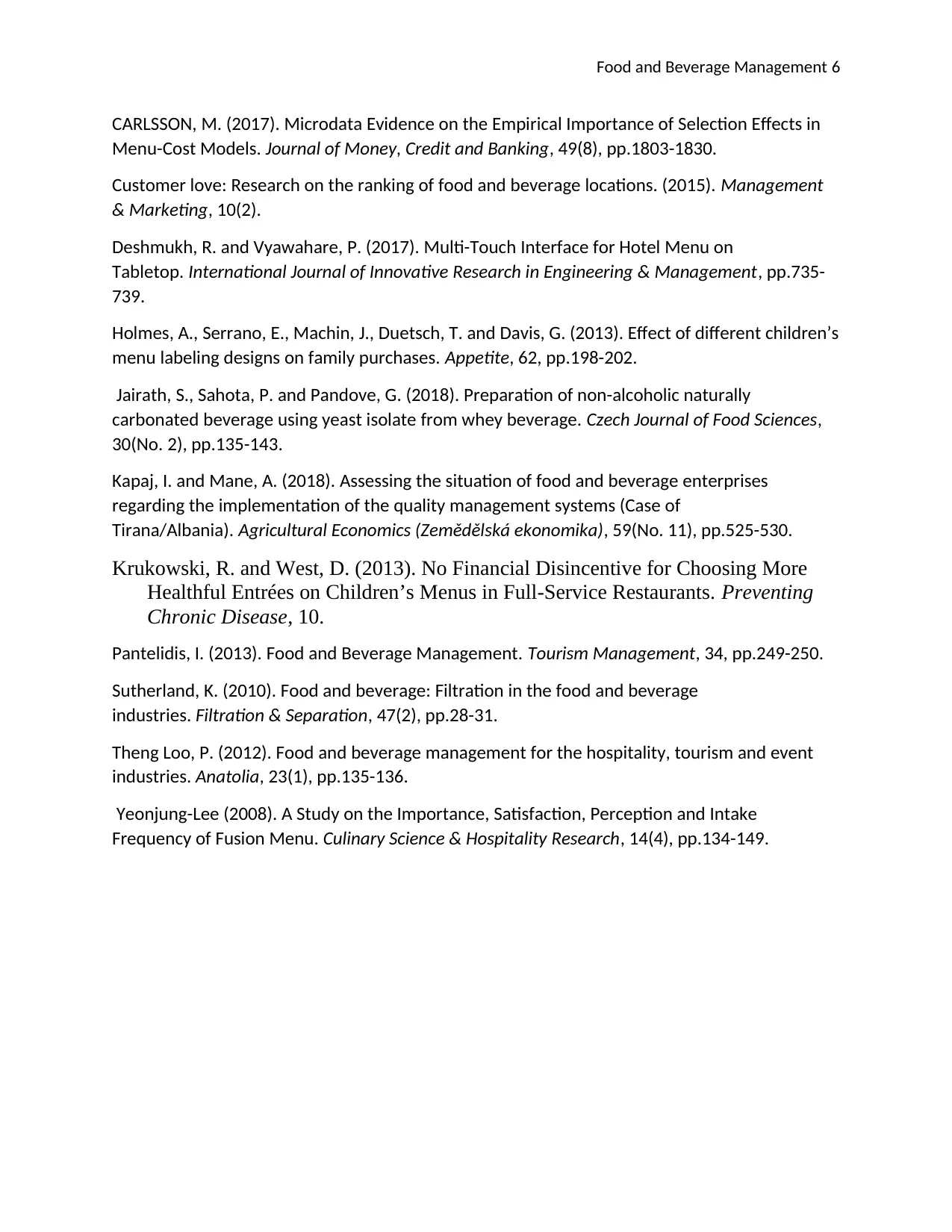
Food and Beverage Management 6
CARLSSON, M. (2017). Microdata Evidence on the Empirical Importance of Selection Effects in
Menu-Cost Models. Journal of Money, Credit and Banking, 49(8), pp.1803-1830.
Customer love: Research on the ranking of food and beverage locations. (2015). Management
& Marketing, 10(2).
Deshmukh, R. and Vyawahare, P. (2017). Multi-Touch Interface for Hotel Menu on
Tabletop. International Journal of Innovative Research in Engineering & Management, pp.735-
739.
Holmes, A., Serrano, E., Machin, J., Duetsch, T. and Davis, G. (2013). Effect of different children’s
menu labeling designs on family purchases. Appetite, 62, pp.198-202.
Jairath, S., Sahota, P. and Pandove, G. (2018). Preparation of non-alcoholic naturally
carbonated beverage using yeast isolate from whey beverage. Czech Journal of Food Sciences,
30(No. 2), pp.135-143.
Kapaj, I. and Mane, A. (2018). Assessing the situation of food and beverage enterprises
regarding the implementation of the quality management systems (Case of
Tirana/Albania). Agricultural Economics (Zemědělská ekonomika), 59(No. 11), pp.525-530.
Krukowski, R. and West, D. (2013). No Financial Disincentive for Choosing More
Healthful Entrées on Children’s Menus in Full-Service Restaurants. Preventing
Chronic Disease, 10.
Pantelidis, I. (2013). Food and Beverage Management. Tourism Management, 34, pp.249-250.
Sutherland, K. (2010). Food and beverage: Filtration in the food and beverage
industries. Filtration & Separation, 47(2), pp.28-31.
Theng Loo, P. (2012). Food and beverage management for the hospitality, tourism and event
industries. Anatolia, 23(1), pp.135-136.
Yeonjung-Lee (2008). A Study on the Importance, Satisfaction, Perception and Intake
Frequency of Fusion Menu. Culinary Science & Hospitality Research, 14(4), pp.134-149.
CARLSSON, M. (2017). Microdata Evidence on the Empirical Importance of Selection Effects in
Menu-Cost Models. Journal of Money, Credit and Banking, 49(8), pp.1803-1830.
Customer love: Research on the ranking of food and beverage locations. (2015). Management
& Marketing, 10(2).
Deshmukh, R. and Vyawahare, P. (2017). Multi-Touch Interface for Hotel Menu on
Tabletop. International Journal of Innovative Research in Engineering & Management, pp.735-
739.
Holmes, A., Serrano, E., Machin, J., Duetsch, T. and Davis, G. (2013). Effect of different children’s
menu labeling designs on family purchases. Appetite, 62, pp.198-202.
Jairath, S., Sahota, P. and Pandove, G. (2018). Preparation of non-alcoholic naturally
carbonated beverage using yeast isolate from whey beverage. Czech Journal of Food Sciences,
30(No. 2), pp.135-143.
Kapaj, I. and Mane, A. (2018). Assessing the situation of food and beverage enterprises
regarding the implementation of the quality management systems (Case of
Tirana/Albania). Agricultural Economics (Zemědělská ekonomika), 59(No. 11), pp.525-530.
Krukowski, R. and West, D. (2013). No Financial Disincentive for Choosing More
Healthful Entrées on Children’s Menus in Full-Service Restaurants. Preventing
Chronic Disease, 10.
Pantelidis, I. (2013). Food and Beverage Management. Tourism Management, 34, pp.249-250.
Sutherland, K. (2010). Food and beverage: Filtration in the food and beverage
industries. Filtration & Separation, 47(2), pp.28-31.
Theng Loo, P. (2012). Food and beverage management for the hospitality, tourism and event
industries. Anatolia, 23(1), pp.135-136.
Yeonjung-Lee (2008). A Study on the Importance, Satisfaction, Perception and Intake
Frequency of Fusion Menu. Culinary Science & Hospitality Research, 14(4), pp.134-149.
⊘ This is a preview!⊘
Do you want full access?
Subscribe today to unlock all pages.

Trusted by 1+ million students worldwide
1 out of 6
Your All-in-One AI-Powered Toolkit for Academic Success.
+13062052269
info@desklib.com
Available 24*7 on WhatsApp / Email
![[object Object]](/_next/static/media/star-bottom.7253800d.svg)
Unlock your academic potential
Copyright © 2020–2025 A2Z Services. All Rights Reserved. Developed and managed by ZUCOL.

